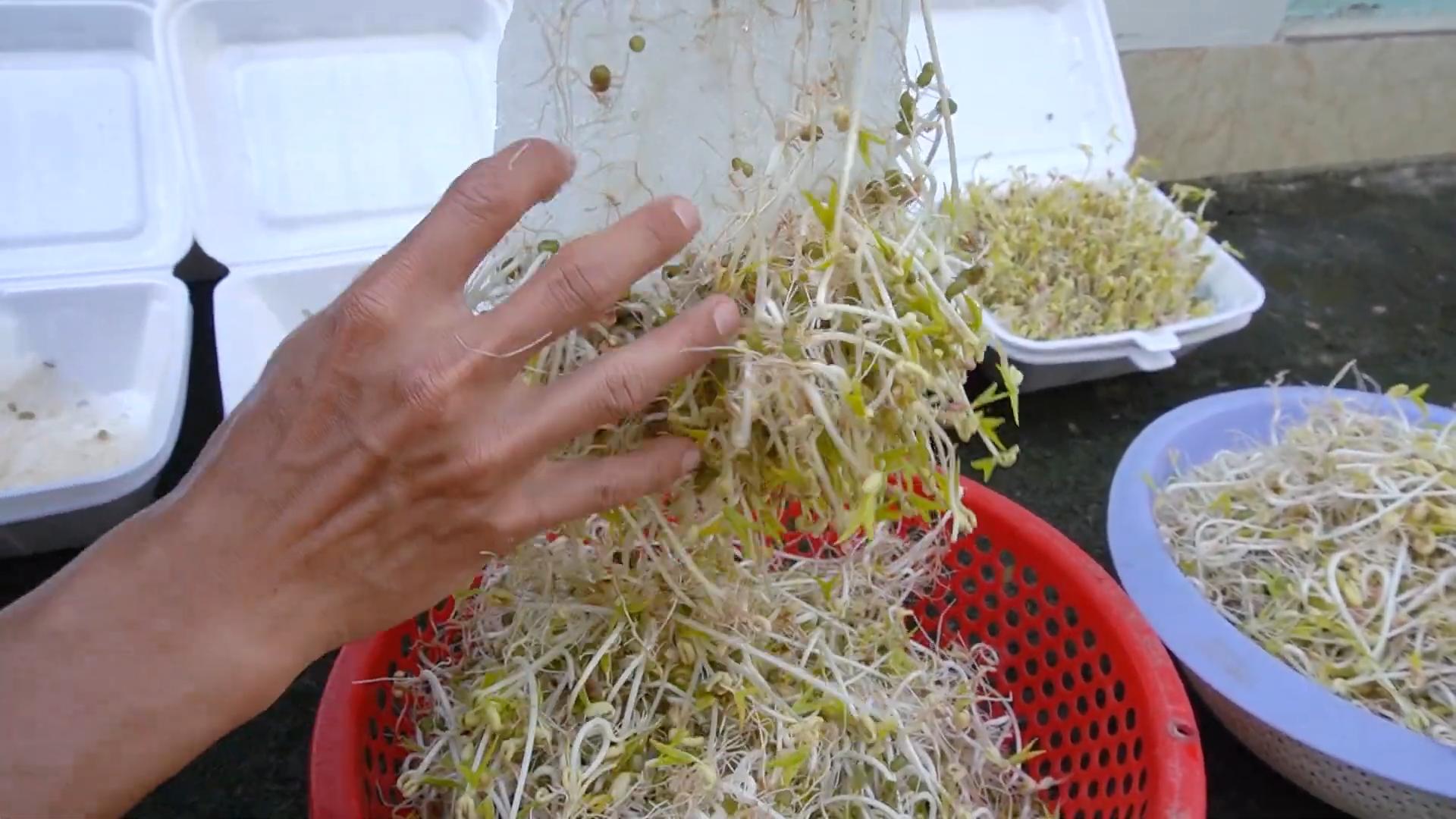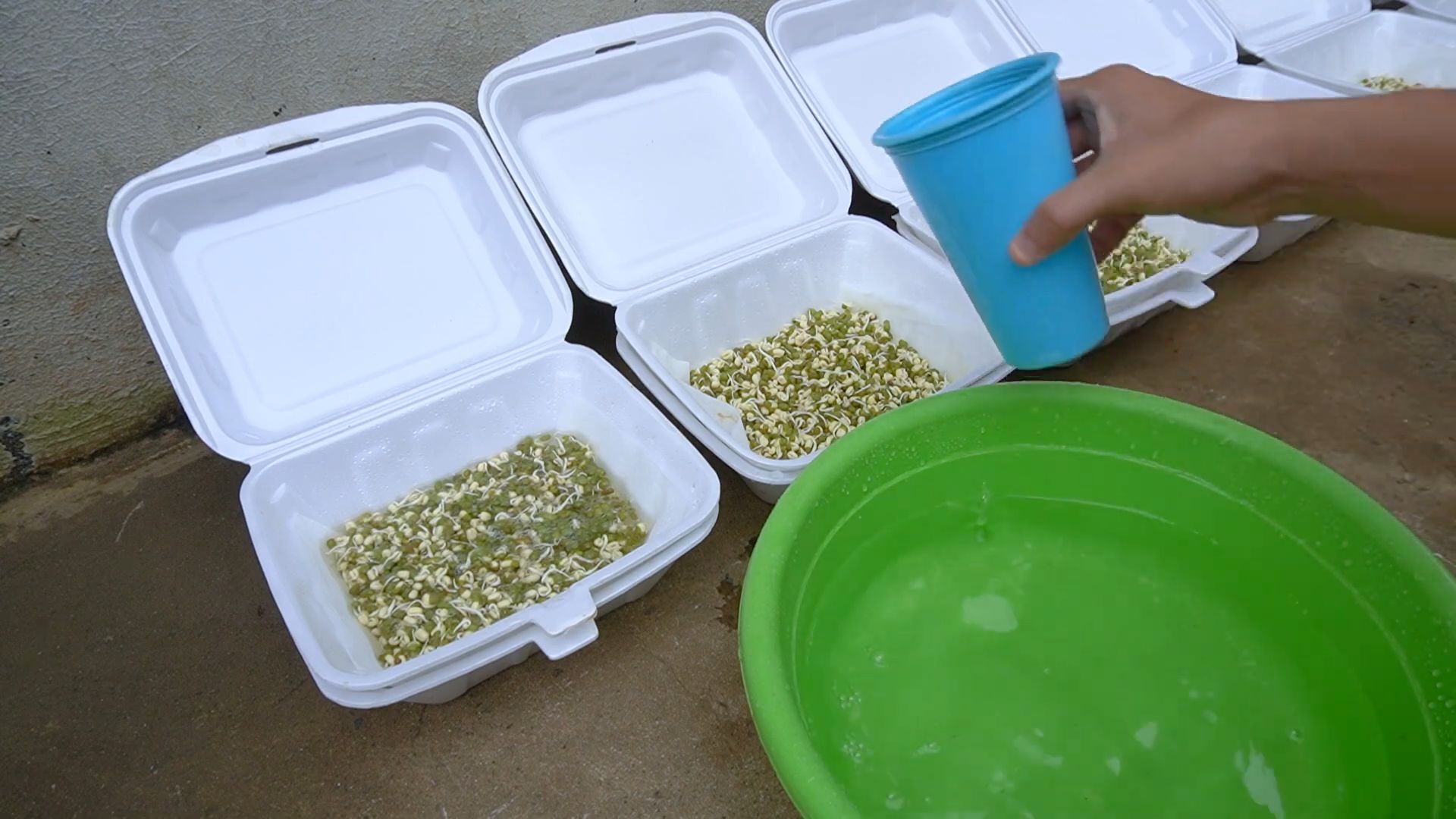Grow bean sprouts in your kitchen – sounds like something only a seasoned gardener can achieve, right? Wrong! I’m here to tell you that cultivating these crunchy, nutritious little powerhouses is surprisingly simple and incredibly rewarding, even if you’ve never grown anything before. Forget those expensive store-bought sprouts that might be days old; imagine having a constant supply of fresh, organic bean sprouts right at your fingertips!
Sprouting beans has a rich history, particularly in Asian cultures, where they’ve been a staple food for centuries. Think of the vibrant stir-fries and fresh salads that benefit from their unique texture and flavor. But beyond their culinary appeal, bean sprouts are packed with vitamins and minerals, making them a fantastic addition to any diet.
In today’s busy world, we’re all looking for ways to eat healthier and save money. That’s where this DIY trick comes in. Learning how to grow bean sprouts in your kitchen is not only a fun and educational project, but it also provides a sustainable and affordable source of fresh produce. Plus, it’s incredibly satisfying to watch those tiny seeds transform into a delicious and nutritious snack in just a few days. So, ditch the store-bought containers and let’s get sprouting! I’m going to show you how easy it is to have a thriving sprout garden right on your kitchen counter.

DIY Bean Sprouts: A Beginner’s Guide to Growing Your Own Crunchy Goodness
Hey there, fellow food enthusiasts! Ever wanted to add a fresh, crunchy element to your salads, stir-fries, or sandwiches? Well, look no further than your own kitchen! Growing bean sprouts at home is surprisingly easy, rewarding, and way cheaper than buying them at the store. Plus, you know exactly what’s going into them – no weird preservatives or questionable growing practices. I’m going to walk you through everything you need to know to become a bean sprout pro.
What You’ll Need
Before we dive in, let’s gather our supplies. The beauty of this project is that you probably already have most of these things lying around:
- Sprouting Beans: Mung beans are the most common and easiest to sprout, but you can also use adzuki beans, lentils, chickpeas, or even radish seeds for a spicier sprout. Make sure they are specifically sold for sprouting and are fresh. Old beans might not germinate well.
- A Wide-Mouth Jar: A quart-sized mason jar works perfectly. You can also use a clean plastic container, but glass is generally preferred.
- Sprouting Lid or Cheesecloth: You’ll need something to cover the jar that allows for drainage and airflow. A sprouting lid is ideal, but a piece of cheesecloth secured with a rubber band works just as well.
- Water: Clean, filtered water is best.
- A Dark Place: Bean sprouts prefer to grow in the dark. A cupboard, pantry, or even a covered bowl will do the trick.
- A Bowl or Tray: To catch any excess water that drains from the jar.
Step-by-Step Sprouting Guide
Alright, let’s get sprouting! This process takes about 3-5 days, so patience is key.
- Soak the Beans:
First, rinse your beans thoroughly under cool water to remove any debris. Then, place about 2-3 tablespoons of beans into your jar. Don’t overcrowd them! They’ll expand significantly as they soak and sprout. Cover the beans with plenty of cool water – about 2-3 times the volume of the beans. This is important because they need enough water to rehydrate and kickstart the germination process.
Secure your sprouting lid or cheesecloth to the jar. Let the beans soak for 8-12 hours, or even overnight. I usually do this before I go to bed so they’re ready to go in the morning.
- Drain and Rinse:
After soaking, drain the water completely through the sprouting lid or cheesecloth. Rinse the beans thoroughly with fresh, cool water. This is crucial to prevent mold and bacteria growth. Swirl the beans around in the jar to ensure they’re all rinsed well.
- Darkness is Your Friend:
Place the jar upside down at an angle in your bowl or tray. This allows any excess water to drain out. Now, find a dark, cool place for your jar. A cupboard or pantry is ideal. If you don’t have a suitable dark spot, you can cover the jar with a towel or place it inside a paper bag.
- Rinse and Repeat:
This is the most important step! Rinse and drain your bean sprouts 2-3 times a day. This keeps them hydrated, prevents mold, and ensures they grow properly. Use cool, fresh water each time. I usually do it in the morning, afternoon, and before bed. Consistency is key here!
- Observe the Magic:
After a day or two, you’ll start to see tiny sprouts emerging from the beans. This is so exciting! Continue rinsing and draining as before. The sprouts will grow rapidly over the next few days.
- Optional: Green Them Up (If You Want):
If you prefer greener sprouts, you can expose them to indirect sunlight for the last day or two. Just be careful not to put them in direct sunlight, as this can overheat them and cause them to dry out. A windowsill with filtered light is perfect. This step is totally optional; you can harvest them while they’re still mostly white if you prefer.
- Harvest and Enjoy:
Your bean sprouts are ready to harvest when they’re about 1-2 inches long. Give them one final rinse and drain. Remove any unsprouted beans or hulls. Store your bean sprouts in an airtight container in the refrigerator. They should last for about a week. Enjoy them in salads, sandwiches, stir-fries, or as a crunchy topping for your favorite dishes!
Troubleshooting: Common Issues and Solutions
Even with the best instructions, things can sometimes go awry. Here are some common problems you might encounter and how to fix them:
Mold Growth
This is the most common issue. Mold usually appears as fuzzy white or gray patches.
- Cause: Insufficient rinsing and drainage, poor airflow, or contaminated beans.
- Solution: If you catch it early, you might be able to salvage the sprouts by rinsing them very thoroughly with cool water and adding a tablespoon of vinegar to the rinse water. However, if the mold is widespread, it’s best to discard the entire batch and start over with fresh beans and a thoroughly cleaned jar. Make sure you’re rinsing and draining frequently enough.
- Prevention: Use fresh, high-quality sprouting beans. Rinse and drain your sprouts 2-3 times a day. Ensure good airflow by using a sprouting lid or cheesecloth. Don’t overcrowd the jar.
Slow or No Sprouting
Sometimes, your beans just don’t seem to want to sprout.
- Cause: Old beans, insufficient soaking, water that’s too hot or too cold, or improper temperature.
- Solution: Make sure your beans are fresh and specifically sold for sprouting. Try soaking them for a longer period (up to 12 hours). Ensure the water temperature is cool, not hot or cold. The ideal sprouting temperature is between 70-75°F (21-24°C).
- Prevention: Buy fresh sprouting beans from a reputable source. Control the temperature of your sprouting environment.
Slimy Sprouts
Slimy sprouts are a sign of bacterial growth.
- Cause: Insufficient rinsing, warm temperatures, or contaminated beans.
- Solution: Unfortunately, slimy sprouts are not safe to eat. Discard the entire batch and start over.
- Prevention: Rinse and drain your sprouts frequently with cool water. Ensure good airflow. Avoid sprouting in excessively warm environments.
Bitter Taste
Sometimes, bean sprouts can develop a bitter taste.
- Cause: Overexposure to light, or certain types of beans.
- Solution: If you’ve exposed your sprouts to light, move them back to a dark place. If the bitterness persists, it might be due to the type of bean you’re using. Some beans, like radish seeds, naturally have a slightly bitter taste.
- Prevention: Keep your sprouts in a dark place. Experiment with different types of beans to find one you enjoy.
Tips for Sprouting Success
Here are a few extra tips to help you become a bean sprout master:
- Start Small: Begin with a small amount of beans (2-3 tablespoons) until you get the hang of the process.
- Use Filtered Water: Tap water can sometimes contain chlorine or other chemicals that can inhibit sprouting.
- Keep it Clean: Thoroughly clean your jar and sprouting lid between batches to prevent contamination.
- Experiment with Different Beans: Once you’re comfortable with mung beans, try sprouting other types of beans and seeds.
- Don’t Be Afraid to Taste: Taste your sprouts regularly to monitor their flavor and texture.
Enjoy Your Homegrown Bean Sprouts!
Growing your own bean sprouts is a fun, easy, and rewarding way to add fresh, healthy ingredients to your diet. With a little practice, you’ll be enjoying crunchy, delicious sprouts in no time. Happy sprouting!

Conclusion
So, there you have it! Growing your own bean sprouts in your kitchen is not only incredibly easy and cost-effective, but it also provides you with a constant supply of fresh, crunchy goodness. Forget those limp, sad-looking sprouts from the grocery store – with this simple DIY trick, you can enjoy vibrant, flavorful bean sprouts whenever you want.
Why is this a must-try? Because it puts you in control. You know exactly what you’re eating, avoiding any unwanted additives or preservatives. Plus, it’s a fantastic way to reduce food waste and embrace a more sustainable lifestyle. Imagine the satisfaction of adding your own home-grown bean sprouts to your salads, stir-fries, or sandwiches, knowing you nurtured them from tiny seeds to delicious sprouts.
But the fun doesn’t stop there! Feel free to experiment with different types of beans. Mung beans are the classic choice, but you can also try adzuki beans, lentils, or even chickpeas for a unique flavor profile. Consider varying the sprouting time to achieve your preferred sprout length and texture. Some people prefer shorter, crunchier sprouts, while others like them longer and more tender.
Another variation to consider is adding a touch of natural light during the last day or two of sprouting. This will encourage the sprouts to develop chlorophyll, resulting in a slightly greener and more nutrient-rich product. Just be careful not to expose them to direct sunlight, as this can overheat them and hinder their growth.
This DIY bean sprout method is a game-changer for anyone who loves fresh, healthy food. It’s a simple, rewarding, and surprisingly addictive process. Once you experience the joy of growing your own bean sprouts, you’ll never want to go back to store-bought again.
We wholeheartedly encourage you to give this DIY trick a try. It’s a fantastic project for families, a great way to introduce kids to the wonders of gardening, and a satisfying accomplishment for anyone who enjoys creating something from scratch.
Don’t be afraid to experiment, adapt the method to your own preferences, and most importantly, have fun! And once you’ve mastered the art of growing bean sprouts in your kitchen, we’d love to hear about your experience. Share your tips, tricks, and variations in the comments below. Let’s build a community of sprout enthusiasts and inspire others to embrace the joys of home-grown goodness! We are confident that you will find this method of growing bean sprouts in your kitchen to be a rewarding and delicious experience.
Frequently Asked Questions (FAQ)
What kind of beans can I use to grow bean sprouts?
The most common and readily available bean for sprouting is the mung bean. However, you can also successfully sprout other types of beans and legumes, including adzuki beans, lentils, chickpeas, and even some types of peas. Keep in mind that different beans may have different sprouting times and flavor profiles. Experiment to find your favorites! Avoid using kidney beans as they contain toxins that are only destroyed by thorough cooking. Sprouting does not remove these toxins.
How long does it take to grow bean sprouts?
Generally, it takes between 3 to 5 days to grow bean sprouts to a usable length. The exact time will depend on the type of bean, the temperature of your environment, and your personal preference for sprout length. Check your sprouts daily and harvest them when they reach your desired size.
What is the best temperature for growing bean sprouts?
The ideal temperature range for growing bean sprouts is between 70°F and 80°F (21°C and 27°C). Avoid temperatures that are too hot or too cold, as this can inhibit germination and growth. A consistently warm environment will promote faster and more even sprouting.
How often should I rinse the bean sprouts?
Rinsing the bean sprouts is crucial for preventing mold and ensuring healthy growth. You should rinse them at least twice a day, preferably in the morning and evening. Use cool, clean water and make sure to drain them thoroughly after each rinse. This helps to remove any accumulated bacteria and keeps the sprouts fresh and hydrated.
How do I prevent mold from growing on my bean sprouts?
Mold growth is a common concern when sprouting beans. To prevent it, ensure proper hygiene and ventilation. Always use clean containers and utensils. Rinse the sprouts thoroughly and frequently, and make sure they are well-drained after each rinse. Avoid overcrowding the sprouts in the container, as this can restrict airflow. If you notice any signs of mold, discard the affected sprouts immediately.
Can I eat the bean sprout roots?
Yes, the roots of bean sprouts are perfectly edible and nutritious. They have a slightly nutty flavor and add a pleasant crunch to your dishes. There’s no need to remove them before eating.
How should I store bean sprouts?
Once your bean sprouts have reached your desired length, you can store them in the refrigerator for up to a week. To keep them fresh, rinse them thoroughly and pat them dry with a paper towel. Store them in an airtight container lined with a clean paper towel to absorb excess moisture.
Are bean sprouts safe to eat raw?
While home-grown bean sprouts are generally safer than store-bought ones, it’s still important to take precautions. Thoroughly rinse the sprouts before eating them raw to remove any potential bacteria. If you are concerned about food safety, you can lightly cook the sprouts before consuming them.
What are the nutritional benefits of bean sprouts?
Bean sprouts are a nutritional powerhouse, packed with vitamins, minerals, and antioxidants. They are a good source of vitamin C, vitamin K, folate, and fiber. They are also low in calories and fat, making them a healthy addition to any diet.
Can I grow bean sprouts without a special sprouting kit?
Absolutely! This DIY trick demonstrates that you don’t need any fancy equipment to grow bean sprouts. All you need is a jar, a lid with holes or cheesecloth, and some beans. This makes it an accessible and affordable project for anyone to try.
What if my bean sprouts don’t sprout?
If your bean sprouts aren’t sprouting, there could be a few reasons. First, make sure your beans are fresh and viable. Old beans may have a lower germination rate. Second, ensure that the temperature is within the ideal range. Third, check that you are rinsing the sprouts regularly and providing adequate moisture. Finally, avoid exposing the sprouts to direct sunlight, as this can inhibit their growth.
Can I use tap water to grow bean sprouts?
While tap water is generally safe, it may contain chlorine or other chemicals that can inhibit sprouting. If you are concerned about the quality of your tap water, you can use filtered water or let the tap water sit for 24 hours to allow the chlorine to dissipate.
How do I know when my bean sprouts are ready to harvest?
Your bean sprouts are ready to harvest when they have reached your desired length and have a crisp, crunchy texture. The exact length will depend on your personal preference, but typically they are ready after 3 to 5 days of sprouting.
Can I regrow bean sprouts from the same batch of beans?
No, you cannot regrow bean sprouts from the same batch of beans. Once the beans have sprouted, they have exhausted their energy reserves and will not sprout again. You will need to start with a fresh batch of beans each time.




Leave a Comment